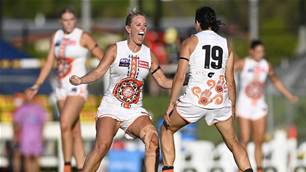The AFL's controversial move to make the AFLW a conference style competition has had an angry backlash. KATE O'HALLORAN gives her take on the row...
On Friday last week, the AFL announced the introduction of a seven-week “conference-style” AFLW season in 2019, followed by two weeks of finals.
The proposed structure would see the competition’s 10 teams divided into two separate groups, with teams in group “A” and “B” facing fellow conference teams once (for four games in total), while also playing three “crossover” games against teams from the other conference group.
The winners of each conference would then play the second-placed team from the other conference in a preliminary final, before progressing to the grand final.
In justifying such a radical departure from routine fixturing, the AFL has argued that it was beholden to three key principles: fairness, transparency and flexibility.
On the contrary, however, such a proposal is a guarantee to further the inequity that women and girls experience at all levels of sport in this country. Head office has, moreover, employed multiple bewildering [il]logical arguments to justify a decision made in its own – rather than girls’ and women’s – interests.
The first of these is that the proposed structure is the “fairest” solution to a situation in which teams are unable to play each other once. This claim relies on accepting the premise that a nine-week season (followed by two weeks of finals) wasn’t possible: the model fans and players alike have consistently favoured, with the AFL yet to provide any sufficient justification as to why this model was not adopted.

Having teams play each other once is the easiest and most logical way to ensure an equitable draw, and yet, the AFL has been unwilling to give the AFLW greater share of the Australian sporting calendar, claiming repeatedly its need for “clean air” to succeed in terms of TV viewership and crowds.
Leaving aside for a moment the lack of faith placed in its own product, the AFL can only justify the conference system as “fair” based on its own refusal to provide the obvious, equitable alternative.
That teams will not only play against their own conference teams once but three “crossover” games (against whom is yet to be determined) furthers the absurdity of the claim that their model provides a “fair” fixture.
On Friday, AFLW boss Nicole Livingstone provided further insight into why the AFL will not run a nine-week season.
"Whilst I recognise that players would like to play longer, and some sections of the fan base would like [the season] to go longer as well, we also need to recognise that at the moment, they're part-time athletes,” she said.
"The feedback we get back through the AFLPA and the players themselves is they're also struggling with things like leave at work, managing time off and the period of the competition… a lot of players spoke to me at the end of the eight-week season saying they were absolutely exhausted.”
The AFL website went on to add that “extra matches would increase costs, including player payments, accommodation and travel, which are all footed by the AFL, rather than clubs.
"The AFL has indicated funding women’s football was a juggling act, with the need to invest in talent pathways around the country, as well as the main competition.”
The AFL has exercised some impressive mental gymnastics to extrapolate that because the players are struggling to cope with multiple competing demands, the solution is to shorten their season. These women thrive on playing football; it’s the reason so many of them willingly jeopardise a living for the privilege of pulling on their club’s guernsey.
Surely, in recognising the very real barriers to women’s participation in elite sport, the aspiration should be to level the playing field rather than reduce women’s time on it.

The most obvious starting point would be to remunerate players sufficiently so that they could fully focus on their AFLW careers. However, the text that accompanies Livingstone’s comments is revealing in this regard: the AFL sees the AFLW as a cost it must “foot” rather than an investment in future generations of women and girls playing the game they love; the game they have been too long denied equitable access to.
The folly, moreover, in the implication that the AFL has been “generous” in funding the AFLW to date is the fact that the AFL is a not-for-profit organisation that last year recorded a net surplus of $48.8 million.
As a not-for-profit organisation, the AFL must surely shoulder a social responsibility to ensure equitable access to its product and associated benefits: ones that are currently overwhelmingly enjoyed by boys and men at the expense of girls and women (especially trans and non binary people, as highlighted by the recent withdrawal of Hannah Mouncey from the AFLW draft).
If the AFL is serious about the “revolution” that AFLW has provided – inspiring a 76% increase in teams of women and girls playing Australian rules football after just its first year – then it must begin to see the AFLW as a social investment, rather than a deficit.
It must also commit to ensuring a situation in which the barriers that women face in participating in elite sport are seen as challenges to be overcome, rather than justifications to further inequity.
Related Articles

Socceroo star's message to kids: Don't be an AFL player

Updated: AFLW Round 2 preview and schedule













